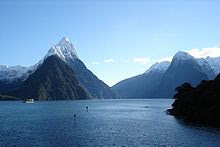- Fjord is long, narrow inlet with steep sides or cliffs.
- Created in a valley carved by glacial activity.
- The word comes to English from Norwegian.
- Whole coast of Norway and the island of Greenland have many fjords.
- Formed by a glacier cuts a U-shaped valley by ice segregation & abrasion of bedrock.
- Glacial melting rebound of Earth's crust as the ice load and eroded sediment is removed
- Most fjords are deeper than the adjacent sea
- Sognefjord, Norway,1,300 m below sea level.
- Fjords have a sill or shoal at their mouth.
 |
| Geirangerfjord, Norway |
- Sill causes extreme currents and large saltwater rapid.
- Saltstraumen in Norway is often described as the world's strongest tidal current.
Features of fojord
1.Coral reef
- Some coral reefs were discovered along the bottoms of the Norwegian fjords.
- New Zealand's fjords are also host to deep sea corals.
2.Skerries
- Rocky coast is divided into thousands of island blocks, some large and mountainous while others are merely rocky points or rock reefs, menacing navigation. These are called skerries.
- The term skerry is derived from the Old Norse sker, which means a rock in the sea.
- Commonly formed at the outlet of fjords.
- Submerged glacially formed valleys perpendicular to the coast join with other cross valleys in a complex array.
- The island fringe of Norway is such a group of skerries
 |
| Magdalenafjord in the high arctic archipelago Svalbard of Norway |
Location of fojord
West cost of Europe
- Faroe Islands
- Westfjords of Iceland
- Eastfjords of Iceland
- Norway
- Kola Bay in Russia
West coast of New Zealand
Northwest coast of North America
Northeast coast of North America
Europe
North America
- Fiordland,southwest of the South Island
- Coast of Alaska, United States: Lynn Canal, Glacier Bay
- British Columbia Coast, Canada: from the Alaskan Border along the Portland Canal to Indian Arm
- Hood Canal in Washington
- Labrador: Saglek Fjord, Nachvak Fjord, Hebron Fjord
- The east coast of Ungava Bay.
- Greenland: Kangerlussuaq, Ilulissat Icefjord, Scoresby Sund
- Saguenay Fjord, Quebec
- Chile
- Ireland Lough Swilly, Carlingford Lough and Killary Harbour
- Scotland
- the Gullmaren on the west coast of Sweden
- Canada Ilulissat Icefjord, the most productive ice fjord in the world.
 |
| Sognefjord in Norway, the third longest fjord in the world, |
The longest fjords in the world are:
- Scoresby Sund in Greenland 350 km
- Greely Fiord/Tanquary Fiord in Canada 230 km
- Sognefjord in Norway 204 km
Deep fjords include:
- Skelton Inlet in Antarctica 1,933 m
- Sognefjord in Norway 1,308 m
- Messier Channel in Chile
 |
| New Zealand's Milford Sound |
 |
| Tysfjord in Norway north of the Arctic Circle boreal zone |
 |
| Hardangerfjord in Hordaland, Norway. |


No comments:
Post a Comment